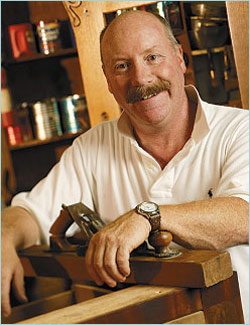 Have you ever looked at a piece of wood furniture that has a few defects or a finish that has begun cracking and wondered if you could redo it yourself? Well, there are a few things to consider before you get out the sander or the stripper.
Have you ever looked at a piece of wood furniture that has a few defects or a finish that has begun cracking and wondered if you could redo it yourself? Well, there are a few things to consider before you get out the sander or the stripper.
Mark Crotty, owner of Doc’s Refinishing on Route 240 in Colden, has been diagnosing and treating wood furniture for more than twenty-five years. Crotty started his career out West after college, and since he returned to Western New York has restored pieces from Roycroft antiques to a Thomas Edison gramophone, gun stocks and guitars, jukeboxes, and a fifteen-foot trestle table dating from the 1800s. “The first thing to know is there’s a difference between restoring and refinishing,” Crotty says. “When you restore a piece you don’t take anything away from it, you add. When you refinish, you take off the old finish. You never want to devalue a piece, so you need to know which way to go before you start.”
Here in WNY, furniture is subjected to dry heat throughout the winter and needs a little moisturizing, just like the skin on our faces. “Wood is porous, so it dries out,” Crotty says. “Even the finishes we put on it are porous. Once a year or so you should polish it using mineral oil, which goes right into the pores. If you keep your wood furniture moist the finish on it will last a long, long time.” Inevitably, though, with time and use, wood furniture will suffer some damage: bald spots, water marks, or scratches. If it’s a good piece of furniture, it’s worth taking it to an expert like Crotty, who knows how to clean and repair high-end antiques without devaluing them.
“Quality all-wood products are getting more and more scarce so older pieces are becoming more valuable,” he says. “Since many European craftsmen immigrated to the U.S. when it was colonized, we have plenty of antiques here that are well worth preserving.” Crotty does not strip furniture by “dipping” it, which also loosens the glue in any joints. He hand-strips everything using a flow system which doesn’t take the stain out, just the finish. The color of the stain is an integral part of the craftsmanship which should be preserved. Usually, he says, hardware should also be kept original, rather than replaced, so the piece retains its value.
from Buffalo Spree Magazine • By Donna Evans-Deyermond; photo by kc kratt